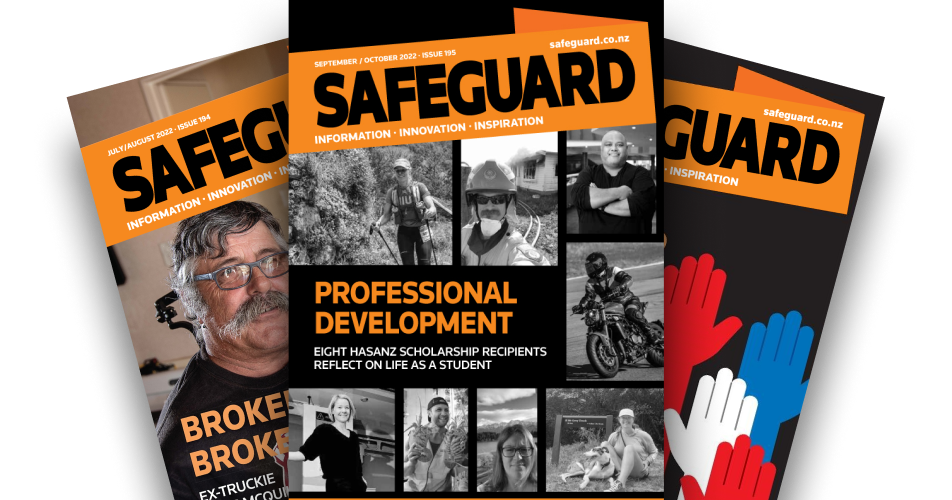How did you get into health & safety?
My first career was as a rock musician back in the 70s and early 80s. Then back in Dunedin I started a video production company with a friend and we made rock videos and TV commercials. In 1985 the aluminium smelter at Tiwai Point rang up and asked me to make a safety video. I didn’t have a clue about safety but they must have liked what we produced because I ended up doing every production and safety training video for them right up until I closed the company in 2013.
I got involved with some Australian H&S consultants at the smelter, which at the time had such a bad safety record it had its own ambulance service. Technically I was a video maker but I became involved in their H&S efforts. By the year 2000 there were zero accidents on the site.
I was getting bored with the video side of things so I went back to university and did a postgrad diploma in H&S and then a master’s degree, where my thesis was on what we did at the smelter and what a zero accident vision looks like. I published a couple of papers out of that and they got some international attention. As a result I was asked to join VIOSH – the oldest postgraduate safety school in Australia – as supervisor of their postgrad courses.
My wife and I weren’t sure about it, but then they said why don’t you do a PhD while you’re here? Which is what I did. I really enjoyed teaching the postgraduate and master’s course. But after five years we got homesick and returned to Dunedin, where I’m now a semi-retired consultant.
The review was produced for NZISM with funding from WorkSafe NZ. What prompted it?
The consultancy Martin Jenkins produced a report back in 2013 after the Royal Commission on Pike River. It was fairly brief but it recommended more or less what we have recommended here, yet it just seemed to have been parked. Hardly anyone knew about it.
In 2020 I did an internal report for NZISM on pathways to professional membership which ended up asking as many questions as it answered. So we talked to HASANZ about it and they talked to WorkSafe and here we are.
You’ve talked to a lot of people in order to produce this review. What surprised you?
Nothing too surprising – I’ve been around a long time. But one thing that struck me was the sheer mismatch between employers’ expectations, students’ expectations, and the provision of tertiary H&S courses. Everyone’s doing what they want with the best of intentions, but it doesn’t really match up. I wanted to find out how we could bring all the disparate areas together.
I’m quite often asked by NZISM members what they should do regarding H&S qualifications, and it’s very difficult to answer. There’s a lot of good stuff happening but there is nothing that you can say, well, you absolutely should do this course, or that course.
A key recommendation in your review is for H&S qualifications offered by tertiary education institutions to be accredited. What brought you to that point?
At VIOSH my students were top safety managers and their average age was probably late 40s. They asked for the course I was teaching to be accredited with the Safety Institute of Australia (now the AIHS). Actually, they demanded it. I did some research and went to my boss and said I think we should be able to teach whatever we like, but the customer is always right. So we started the course accreditation process and it drove me mad. It took six months of hard work to get there, but it made me understand how the Australians lock course accreditation into the Body of Knowledge (oshbok.org.au), which both students and employers valued highly.
Towards the end of each year some of the big Australian companies would get in touch asking me to put forward some of our students, which helped me to understand the beauty of having a H&S course accredited to an industry rather than just accredited to a university.
The more I talked to people here, the more I realised this is the kind of thing we need in New Zealand: to have our H&S courses linked to evidence-based sources of knowledge like Australia’s OHS Body of Knowledge (oshbok.org.au), or INSHPO, or IOSH.
But one thing nags at me. Employers often say they just want “the right person”, and that if they could find this person they would arrange for them to get a H&S qualification. In other words, they wanted to somehow implant their way of doing H&S into the person, when it should be the other way around.
It’s doing what everybody else does and thinking it’s good enough. I’m a great believer in level 7 and level 8 education, so that students are introduced to critical thinking and can reflect on how much they don’t know. That’s essential for a health & safety generalist.
How do the H&S qualifications currently taught in New Zealand stand up?
Most of them seem to be pretty good. There’s a lot of teaching expertise there. But only a few of them are linked to acknowledged evidence-based knowledge bases. That’s where the concept of course accreditation comes in, so that NZISM could point to a course and say: we’ve looked at the body of knowledge it uses, we’ve looked at how qualified its teachers are, and it meets our criteria.
In Australia they’re starting to talk about using a master’s degree in H&S as the professional standard. In New Zealand we haven’t even got a bachelor’s degree in H&S.
There are some very popular H&S courses which could benefit from a bit of tightening. It was only in 2010 that I did my postgrad diploma and I was still being taught about Heinrich’s triangle from 1931 and it’s just nonsense. So there are a few things like that which can slip through.
Accreditation would provide the assurance that a course has the evidence base and teaching expertise required.
You’re keen on the idea of a chartered professional, like in engineering or surveying for instance.
If you want to build a factory you can’t just do it using your builder mate with a concrete mixer. You’ve got to have a chartered engineer involved. But it’s strange that what goes on inside the factory is just open slather until you hurt someone and might get prosecuted.
I’d like to see the universities offer a chartered H&S professional degree, meaning a postgraduate degree. It’s aspirational, but we have to start somewhere.
Experience in H&S is very important but it doesn’t inherently indicate knowledge. Some H&S practitioners seem to be focused solely on making their clients compliant with the law. They quickly learn the lingo, the vocabulary, but they lack any sort of credible education.
There are some courses which seem to be about 70% compliance and 30% safety. Ideally they would be one and the same, but they’re not.
How has the review been received?
There’s been a lot of support for it. No one has contacted NZISM saying it’s rubbish! HASANZ has adopted it, and WorkSafe seems happy with it. The next stage will be some sort of scoping study to look at what can be put into practice.
After a workplace incident you often hear people saying it was a chance in a million and there was no way to prevent it. With my students at VIOSH I used to do sums to demonstrate that in a typical repetitive business, that chance in a million comes around fast. It’s very difficult to identify it in advance. But that’s what we have to do.
I look back on the report of the Independent Taskforce in 2013, which aimed to make New Zealand the safest country in the OECD. But we’re still languishing. So we’ve got to do something.




